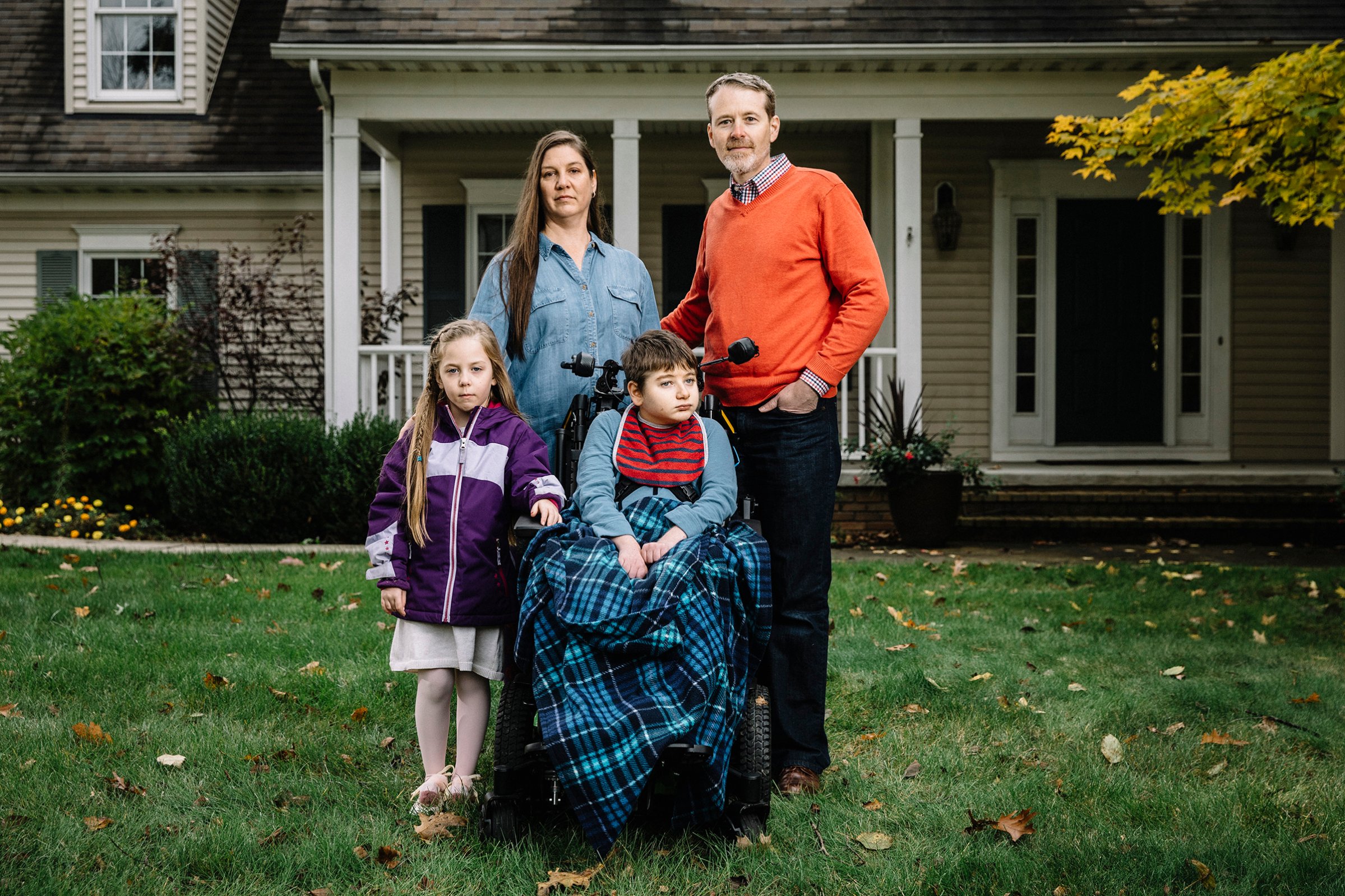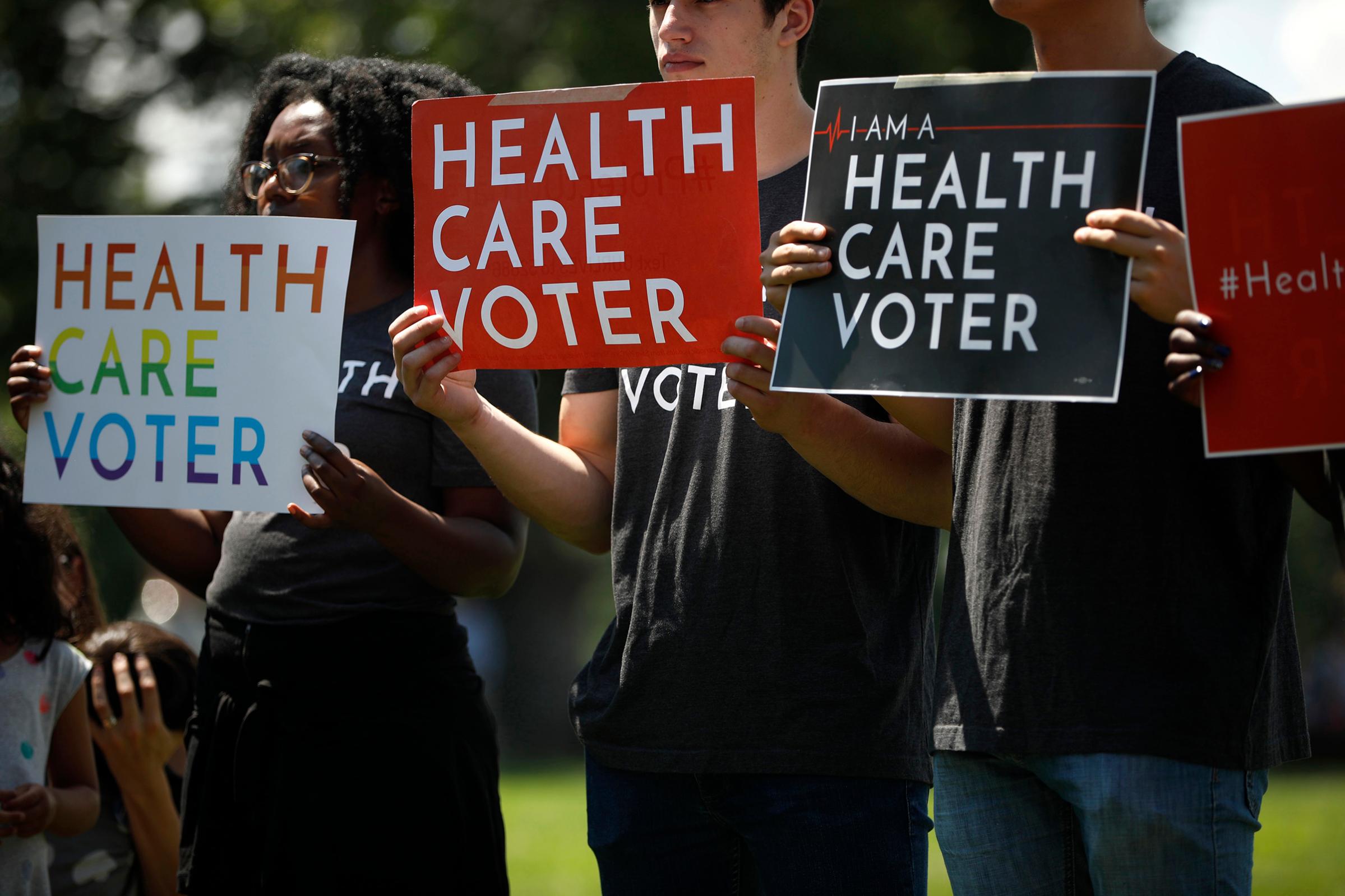
Kevin Johnson, the president of a precision tool–manufacturing shop in Mentor, Ohio, pins a new bar graph to the bulletin board across from his desk each month. It shows the cost-to-income ratio at his company, Fischer Special Tooling, and it’s not a pretty picture. Expenses are rising while revenues decline; the image slopes painfully to the right. Johnson, who’s tall and lean and has an engineer’s no-nonsense manner, rattles off a list of challenges facing the small business that has been in his family since the early 1980s, from a poorly trained labor pool to low-cost foreign competitors. But what’s most on his mind these days is health care. “It was killing us,” he says.
Johnson slides another graph across his tidy wooden desk. This one shows how much Fischer Special Tooling has spent each year on health care for its 13 employees. For years, the figure climbed by an average of 8.5% annually, peaking at $96,000 in 2016. But since then, costs have steadily declined. This year, the company spent $60,000 on health care: a 25% decrease from two years ago. One big reason, Johnson says, is the Affordable Care Act (ACA), better known as Obamacare.
He’s not alone. Thanks to various ACA provisions, the overall rise in health care costs has slowed. “I’m not saying the ACA is perfect,” says Johnson, 55, who identifies as neither Democrat nor Republican and says he has often voted for candidates of both parties. “I’m saying, let’s keep the parts that work and fix the parts that don’t.”
Finding political leaders with a plan to do that is a high priority for tens of millions of Americans this election season. In poll after poll, voters say access to affordable care is their top concern. An October Kaiser poll found that registered Democratic and independent voters in battleground districts listed health care as the most important issue. With the exception of black women–who said health care was the second most important issue behind racial justice–women of all ages, races and party affiliations cite health care as their foremost priority, according to a poll conducted by TIME and SSRS in August and September.
For good reason. While the parts of the ACA that work may have helped keep Fischer Special Tooling in business, the parts that don’t are crushing American families. Since 2008, the average family’s health-insurance premium has increased 55%, twice as fast as wages, and deductibles have tripled. While the ACA has succeeded in extending health care coverage to 20 million people through Medicaid expansions and federal subsidies, it has done very little to keep costs down for many others. “It’s fair to say it has failed middle-income Americans,” says Larry Levitt, a senior vice president at the nonpartisan Kaiser Family Foundation.
For years, Republicans seemed happy to let Obamacare fail–and even to accelerate the process. The Trump Administration has systematically weakened the ACA, cutting back its patient protections, undermining insurance markets and boosting state decisionmaking at the expense of federal rules. The Administration has also refused to fully defend the ACA against a lawsuit brought by 20 Republican attorneys general and governors, who argued in federal court in September that the entire health care law is invalid.
But in the run-up to the Nov. 6 midterm elections, something interesting has happened. The widespread anxiety about health care has prompted a political shift. On Election Day, conservative voters in Utah, Idaho, Nebraska and Montana are expected to join other moderate states, like Maine and Virginia, in approving ballot measures that extend Medicaid eligibility–contravening Republicans’ longtime effort to limit the program. In states like Georgia, Florida and Ohio, efforts to expand access to Medicaid have become a central, and popular, campaign issue. In August, a Reuters/Ipsos survey found that 70% of Americans, including a slim majority of Republican voters, now support some version of the universal health care proposal known as Medicare for All, which was championed by Vermont Senator Bernie Sanders in 2016. Not too long ago, it was considered politically radical.
Now dozens of Republican office holders and candidates this election cycle have abandoned the GOP’s long-standing campaign promise to repeal the ACA. Some who once opposed Medicaid expansion, like Ohio Republican gubernatorial hopeful Mike DeWine, have changed their position. Others, including Republican Senate candidates Josh Hawley in Missouri and Patrick Morrisey in West Virginia, as well as Governor Scott Walker in Wisconsin, have promised in campaign speeches to defend the ACA’s popular protections for people with pre-existing conditions. But they also stop short of reconciling that campaign position with their ongoing support for the Republican lawsuit that would dismantle Obamacare.
Democrats are seizing on the political opportunity this shift has presented them. After years of tiptoeing around Obamacare’s dismal approval ratings, the party is suddenly embracing health care on the trail: 61% of pro-Democratic House ads from Sept. 18 to Oct. 15 mentioned health care, compared with just 10% of all Democratic ads in 2016, according to the Wesleyan Media Project. “It’s a powerful issue,” says Brad Woodhouse, a longtime Democratic operative and the executive director of the health care advocacy group Protect Our Care. “Republicans’ opposition to health care has become an anvil around their necks–and a political gift to us.”

Americans who vote on health care issues are often intimately familiar with the wonkier aspects of the Affordable Care Act. Speaking quietly in a living room in Hudson, Ohio, Christine Callahan, who manages a small family-run flooring business with her husband Larry, lays out the list of issues that are most important to her this election, including preserving a prohibition on lifetime caps for insurance and ensuring affordable access to coverage for people with pre-existing conditions. For her family, Callahan tells TIME, the prospect of losing those ACA protections is “as scary as it gets.”
The Callahans, who buy their family’s health care coverage on the market, have an 11-year-old son, Andrew, who was born with an undiagnosed genetic condition that has left him immobile and unable to speak. Andrew requires constant care and an expensive wheelchair. His antiseizure medicine alone costs $1,800 per month. To Callahan, the Republican lawsuit to dismantle Obamacare and the Trump Administration’s ongoing efforts to weaken patient protections are a threat to her family. Without the ACA provisions that dictate her family’s insurance plan, she says, “I honestly don’t know what we would do.”
Like Kevin Johnson, the Callahans live in Ohio’s 14th District, which stretches along Lake Erie, encompassing both Cleveland suburbs and more industrial areas. It’s a Republican-leaning district that Barack Obama lost by less than a point in 2008 and Trump won by 11 in 2016. Since 2013 it has been represented in the U.S. House by Republican Dave Joyce, who campaigned back then on a promise to eliminate Obamacare. Joyce voted to repeal the ACA 31 times–a record he once touted proudly on his website.
But this year Joyce is singing a different tune. Facing an unexpectedly stiff challenge from Democrat Betsy Rader, a civil rights attorney and former health care lawyer, Joyce has recently campaigned on his decision to vote against his fellow Republicans’ attempt to repeal the ACA last year. “When Republican leaders in Congress tried to take away protections for people with pre-existing conditions, I said no,” he said in an August political ad that ran locally. His previous voting record on repealing Obamacare also no longer appears on his site. Two months later, Joyce seemed to return to his previous position. “I’d vote to repeal [the ACA] tomorrow,” the Congressman told the Wall Street Journal in October. (Joyce’s campaign did not respond to TIME’s multiple requests for an interview.) A large number of his constituents benefit directly from Obamacare: last year, roughly 33,000 people in Ohio’s 14th received health coverage through the law, according to Kaiser.
Threats to do away with the elements of Obamacare that are working are only part of the problem for the GOP this year. The party has also failed to follow through on its promise to fix what hasn’t worked with the law. In 2017, despite controlling both houses of Congress and the presidency, the GOP failed to muster enough votes to deliver on its long-standing promise to “repeal and replace” Obamacare. Dozens of Republican lawmakers, like Joyce, who favored repealing the ACA when they knew Obama would veto the effort ultimately voted against Republican leaders’ attempts to tank the law, in part because they had no program to offer in its place.
Republicans have nonetheless succeeded in hobbling the ACA, stripping away its tax base, unraveling some of its most powerful provisions and destabilizing its insurance markets. Over the past year, the GOP canceled funding for the Obamacare provision that requires all Americans to have health insurance; created new, slimmed-down plans that cost less but don’t cover much; scrapped a $10 billion subsidy to insurers for covering the sickest customers; and cut the law’s budget for advertising–all moves that have weakened the public insurance market.
Last October, the Trump Administration pushed through new rules that free states to dodge some of Obamacare’s most important provisions. The new state-based rules, which will go into effect as early as next year, could permit insurers to exclude people with pre-existing conditions or charge them higher premiums. States could also decide to permit insurers to refuse to cover things like maternity care, mental-health care or prescription drugs, which are currently required under the ACA. “It leaves the door open for states to do an end run around the ACA,” says Levitt of the Kaiser Family Foundation.
Such efforts have reshaped Obamacare in ironic ways. The GOP has undermined the free-market parts of the ACA–the exchanges on which private insurers compete to sell health plans to citizens–while inadvertently strengthening the federal government’s role in the law. For example, citizens who now receive coverage through Obamacare’s Medicaid expansion have been unaffected by Republican efforts to destabilize the markets. That population doesn’t purchase insurance plans on the exchanges, so they don’t care how expensive the premiums in those plans are. Even those who do buy their insurance through the exchanges are for the most part unaffected by the GOP moves. Because roughly 83% of them receive federal subsidies that increase every time premiums rise, they too are protected against unstable prices.
The result is a deeply dysfunctional system. The federal government now spends tens of billions each year subsidizing millions of Americans’ health care coverage on the public exchanges. That’s much more expensive than simply offering those same people coverage under Medicare or Medicaid, according to independent analyses of the law. Meanwhile, the roughly 1.3 million people who do still buy insurance on the exchanges but whose incomes are too high to qualify for federal subsidies must choose between expensive plans and going without insurance entirely. Roughly 16% of nonelderly Americans lack health insurance today, according to the Commonwealth Fund. That’s down from 20% in 2013, the year before most of the ACA went into effect, but up from just 13% in 2016.

On a cool, sunny day in late September, about four dozen voters gathered in a well-appointed living room in the upscale Cleveland suburb of Hudson, Ohio, to meet Rader. The Democratic candidate’s short speech covered the party’s key talking points, from curbing corruption to protecting the environment. But Rader’s primary message was safeguarding health care. “It’s the most important issue to families here,” Rader tells TIME, sitting behind the desk in her small campaign office a short drive away, in Willoughby, Ohio. “People are literally terrified at the prospect of losing protections for pre-existing conditions.”
Like many Democratic candidates running in Republican districts this cycle, Rader’s solution is a reflection of toolmaker Kevin Johnson’s admonition to keep what works and fix what doesn’t. Rader wants to preserve the ACA’s Medicaid expansion and other patient protections. And to combat rising costs, she wants to allow middle-class families to purchase a relatively inexpensive Medicare plan on the ACA exchanges, in the same way they can now purchase private insurance there. Rader’s proposal, which is often known as the public option or Medicare-X, has been around for years. (It was originally popularized by two moderate Democrats, Senators Tim Kaine of Virginia and Michael Bennet of Colorado.) In 2013, the Congressional Budget Office calculated that such a plan would reduce the federal deficit by $158 billion over a decade; the savings would come from decreasing the amount the government currently pays in federal subsidies to underwrite the purchase of private health plans.
Conservatives have long opposed proposals allowing people to buy into public Medicare or Medicaid plans, painting them as a prelude to socialized medicine. In Ohio’s 14th District, Joyce ran ads arguing Rader’s support for a public option amounted to a government takeover of health care, a once potent GOP attack line. But the politics are changing, and a growing number of voters are jumping on the “preserve and fix” bandwagon. Legislators in roughly a dozen states have considered proposals that would allow people to purchase plans from state-based Medicaid programs. In New Mexico, legislators recently passed a measure to study how a Medicaid buy-in option would work on its exchange.
Elsewhere, Republicans who have campaigned to repeal Obamacare in its entirety now say they support other provisions designed to protect people with pre-existing conditions. “Republicans will totally protect people with Pre-Existing Conditions, Democrats will not!” President Trump tweeted in October. The President has not explained why, in a court filing in June, his Administration urged a federal court in Texas to specifically strike down the two Obamacare provisions requiring insurers to cover people with pre-existing conditions and preventing them from charging such people higher premiums.
Republican candidates have often failed to explain such contradictions in their positions on health care. In Missouri, for instance, Hawley ran an ad claiming to support protections for people with pre-existing conditions while omitting the fact that he’s one of the attorneys general currently challenging the ACA’s patient protections. If he wins that lawsuit, federal protections for people with pre-existing conditions would disappear.
Meanwhile, Democratic incumbents in red states are campaigning this year to protect a law that was a political liability in past elections. In West Virginia, Democratic Senator Joe Manchin has gone after his opponent, Morrisey, the former state attorney general, for supporting the lawsuit to dismantle the ACA. In Indiana, Democratic Senator Joe Donnelly is touting his vote last year against repealing Obamacare. “It would have been impossible to imagine red-state Democrats running on protecting the health care law in 2014,” says Woodhouse, the Democratic operative. “It’s a stunning reversal.”
Perhaps the best chance to address voters’ demands for solutions to the health care problem is coming at the state level. Country-wide, legislators are passing bills that increase access to affordable care by seizing on the most popular components of the ACA. “If you want to fix health care, you need to realize that nothing is going to happen in the U.S. Congress in the near future,” says Tom Kise, the senior director of public affairs at a new nonprofit, United States of Care, which works largely at the state level to improve access to affordable care. “It’s got to come from the states.”
Levitt, the Kaiser health care expert, says recent Republican efforts to unwind the law federally might have the effect of saving it on the state level. By eliminating the ACA’s least popular provision, the requirement to buy health insurance, the Republicans have made the law more palatable to many GOP state legislators. And shifting rulemaking power away from the distrusted feds in Washington “might make the law more sustainable in the long run,” Levitt says.
The political shift on health care may be accelerating. A majority of Americans now support some version of a single-payer system, according to a Washington Post/Kaiser Family Foundation poll released in April. Dozens of top Democrats, including many of the party’s 2020 presidential hopefuls, have outright endorsed Medicare for All, the proposal that would allow all Americans, regardless of income or age, to buy into the federal health care program that now serves people over 65.
There is an opportunity for politicians in this moment. Even the voters who have the most at stake in the health care fight, like Johnson or the Callahans, often don’t have a specific policy prescription in mind. Back at his desk at Fischer Special Tooling, Johnson says he sees benefits in stabilizing the ACA and expanding access to subsidies. But he also cautions against creating more problems with poorly run government programs. “I’m not conservative. I’m not liberal. I am a member of the Rational Party,” he says. “I don’t care about politics. I care about creating policies that do what’s best for the public good, and that means fixing health care.” The candidates who offer a way to do that may well be the ones who win on Nov. 6.
More Must-Reads from TIME
- Introducing the 2024 TIME100 Next
- The Reinvention of J.D. Vance
- How to Survive Election Season Without Losing Your Mind
- Welcome to the Golden Age of Scams
- Did the Pandemic Break Our Brains?
- The Many Lives of Jack Antonoff
- 33 True Crime Documentaries That Shaped the Genre
- Why Gut Health Issues Are More Common in Women
Write to Haley Sweetland Edwards at haley.edwards@time.com